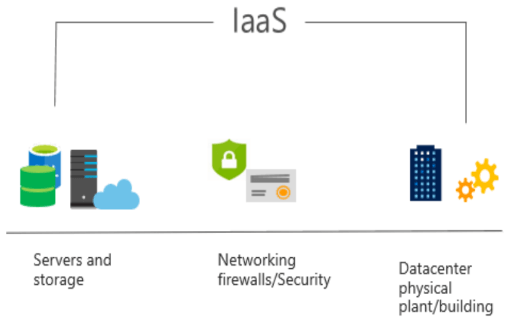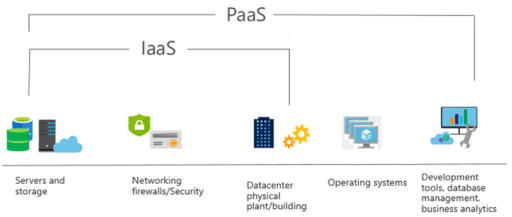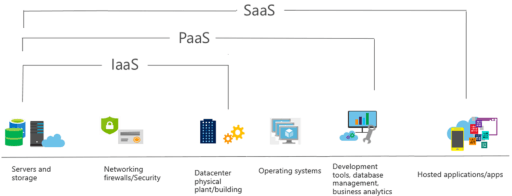Last updated on July 13th, 2024 at 10:35 am
We will discuss Cloud Services, types of cloud services – IaaS, PaaS, and SaaS, Cloud Services Comparison – IaaS vs PaaS vs SaaS, Server-based computing, serverless computing, and its advantages & disadvantages.
Table of Contents
1. What is Cloud Services?
A Cloud Service is a data or application that is hosted by a third-party provider and delivered over the internet to users.
Users do not need to have their infrastructure or hardware to access a cloud service, as the provider supplies and manages the necessary resources. Through a subscription-based system, organizations can make use of infrastructure, platforms, technologies, software, and more without requiring physical hardware.
1.1 Infrastructure as a Service (IaaS)
In this cloud service, Infrastructure (Build pay-as-yo-go) rents servers, virtual machines, storage, network, and operating systems from Cloud providers.

1.2 Platform as a Service (PaaS)
This cloud service provides the environment for building, testing, and deploying software applications, without focusing on managing underlying infrastructure.

1.3 Software as a Service (SaaS)
In this cloud service, Users connect to and use cloud-based apps over the internet. Microsoft Office 365 email and calendars are examples.

2. Cloud Service Comparison – IaaS vs PaaS vs SaaS
| IaaS | PaaS | SaaS |
|---|---|---|
| The most flexible cloud service. | Focus on application development. | Pay-as-you-go pricing model. |
| Can configure and manage the hardware for the application. | Platform management is handled by the cloud provider. | Users pay for the software they use on a subscription model. |
3. Shared Responsibility Model
| Components | On-Premises (Private Cloud) | Infrastructure (as a service) | Platform (as a service) | Software (as a service) |
|---|---|---|---|---|
| Data & Access | Client manages | Client manages | Client manages | Client manages |
| Applications | Client manages | Client manages | Client manages | Cloud Provider manages |
| Runtime | Client manages | Client manages | Cloud Provider manages | Cloud Provider manages |
| Operating System | Client manages | Client manages | Cloud Provider manages | Cloud Provider manages |
| Virtual machine | Client manages | Client manages | Cloud Provider manages | Cloud Provider manages |
| Compute | Client manages | Cloud Provider manages | Cloud Provider manages | Cloud Provider manages |
| Networking | Client manages | Cloud Provider manages | Cloud Provider manages | Cloud Provider manages |
| Storage | Client manages | Cloud Provider manages | Cloud Provider manages | Cloud Provider manages |
4. Server-based Computing
Server Computing is a program or a device that provides functionality for called clients which are other programs or devices. Server computing continues to remain the most reliable option in the minds of business owners.
Many people prefer the traditional method, especially regarding security and data protection, as it’s proven to be bulletproof.
4.1 Benefits and Disadvantages of Server Computing
- Benefits of Server computing include Full access, Security, and independence on internet connection.
- Full Access. Managed and maintained within the company by the in-house IT team, on-premise servers allow unlimited access.
- Security. As all of your critical data is safely stored on the premises and no third-party service has access to it, the server computing model is known for high security.
- No dependency on internet connection. On-premise servers allow IT staff to access valuable data at any time, even when the internet connection is poor or unstable.
- Disadvantages of Server computing include Cost. High Cost is probably the largest disadvantage of on-premise servers.
5. Serverless Computing
Serverless Computing is the technology of abstracting the servers, operating systems, and infrastructures. It is a cloud computing execution model in which the cloud provider dynamically manages the allocation of the machine resources.
The term ‘serverless’ does not mean that no server is used. It takes care of the server and the underlying infrastructure for the user so that the user can easily manage application development.
5.1 Benefits and Disadvantages of Serverless Computing
- Benefits of Server computing include Cost efficiency, Scalability, Easy deployment, and Improved developer productivity.
- Cost efficiency. Proves to be cost-effective as the services provided follow a pay-per-use model. The customer only needs to pay for the services it uses and does not need to reserve or pay for resources beforehand.
- Scalability. Allows applications to scale automatically, based on the number of requests or events.
- Simplified Deployment. With serverless computing, developers can deploy their applications quickly and easily without worrying about managing servers or configuring infrastructure.
- Enhance developer productivity. Allows developers to deploy their applications quickly and easily without worrying about managing servers or configuring infrastructure will improve developer productivity and reduce time-to-market.
- Disadvantages of Server computing include Limited control, Vendor lock-in, and debugging challenges.
- Limited Control. Doesn’t provide developers with complete control over the infrastructure, which can be a disadvantage for some applications.
- Vendor Lock-in. Requires developers to use the services provided by the cloud provider, which can create vendor lock-in.
- Debugging. Applications can be more difficult than traditional applications because the developer does not have direct access to the infrastructure.
6. Server-based vs Serverless Computing
| Aspects | Serverless | Server-Based |
|---|---|---|
| Cost | In a serverless architecture, you follow a pay-per-use model which is a cost-effective solution. | Maintaining servers leads to a cost overhead due to constant server maintenance and monitoring. |
| Portability | Vendor lock-in is a major drawback, i.e. migrating to other service providers is difficult. | In a service-based model, you can easily move applications between various cloud providers or on-premise servers. |
| Scalability | Serverless architecture provides the provision of automatic scaling where resources are added or released based on the traffic. | Service-based models require manual intervention to scale up or scale down the application. |
| Performance | Serverless architecture leads to variable performance in case of cold and warm starts. | Service-based models have a consistent performance. |
Azure Functions is a code running the service and not the underlying platform or infrastructure. It creates infrastructure based on an event.
Azure Logic is a cloud service that helps to automate and orchestrate tasks, business processes, and workflows when you need to integrate apps, data, systems, and services.
Some famous platforms for serverless computing are AWS lambda, Microsoft Azure, and Google Cloud Platform.
FAQs
What is Cloud Services?
A Cloud Service is a data or application that is hosted by a third-party provider and delivered over the internet to users. Users do not need to have their infrastructure or hardware to access a cloud service, as the provider supplies and manages the necessary resources.
Difference between IaaS vs PaaS vs SaaS?

In IaaS, Infrastructure (Build pay-as-yo-go) rents servers, virtual machines, storage, network, and operating systems from Cloud providers.
In PaaS, it provides the environment for building, testing, and deploying software applications, without focusing on managing the underlying infrastructure.
In SaaS, Users connect to and use cloud-based apps over the internet. Microsoft Office 365 email and calendars are examples.
What is Server-based Computing?
Server Computing is a program or a device that provides functionality for called clients which are other programs or devices. It continues to remain the most reliable option in the minds of business owners.
What is Serverless Computing?
Serverless Computing is the technology of abstracting the servers, operating systems, and infrastructures. It is a cloud computing execution model in which the cloud provider dynamically manages the allocation of the machine resources.
Difference between Server-based Computing and Serverless Computing?
In Service-based computing, you can easily move applications between various cloud providers or on-premise servers. It requires manual intervention to scale up or scale down the application. Its have a consistent performance.
In Serverless Computing, you follow a pay-per-use model which is a cost-effective solution. It provides the provision of automatic scaling where resources are added or released based on the traffic. It leads to variable performance in case of cold and warm starts.